Promoting Mental Health Illness and Wellbeing
VerifiedAdded on 2023/01/03
|10
|2959
|63
AI Summary
This document discusses the mental health status of a client in a case study, exploring behavioral symptoms, reduced mood and speech, and increased thinking and mutability. It also examines two factors contributing to the client's current mental health status. Additionally, it discusses the positive aspects of mental health recovery, including respect, empowerment, and hope, and how they can positively contribute to the client's journey of healing.
Contribute Materials
Your contribution can guide someone’s learning journey. Share your
documents today.

Running head: PROMOTING MENTAL HEALTH ILLNESS AND WELLBEING 1
Promoting Mental Health Illness and Wellbeing
Student’s Name
Institutional Affiliation
Promoting Mental Health Illness and Wellbeing
Student’s Name
Institutional Affiliation
Secure Best Marks with AI Grader
Need help grading? Try our AI Grader for instant feedback on your assignments.

PROMOTING MENTAL HEALTH ILLNESS AND WELLBEING 2
Promoting Mental Health Illness and Wellbeing
Using relevant literature critically discuss the mental health status of the client in
the case study.
One of the most common expressions of depression disorder is behavior. According to
the Diagnostic and Statistical Manual of Mental Disorders V, a persistent and consistent daily
behavior pattern is a prerequisite for a patient to be diagnosed with depressive disorders,
according to the. The American Psychiatric Association (2013) reveals that a lack of interest in
certain activities is a profound signal used in the diagnosis of patients. Restlessness,
psychomotor agitation, retarded thinking; feelings of anxiety, eye contact, and posture are some
of the features characteristic of patients with depressive disorder. In this case study, Munny’s
behavior indicates these symptoms, and this is a pointer to depression. For instance, Munny has
had reduced physical activity whenever he gets into his house. He only sleeps and has no interest
in anything else, and has diminished eye contact when talking to the nurse. Furthermore, he does
not give his children much attention as he used to, which signifies his disinterest in people and
anything going on around him. (Wang et al., 2019). Behavioral symptoms are critical in the
diagnosis of depressive disorders among patients. Therefore, behavioral symptoms should be
carefully checked when examining the mental status of a patient.
Another indicator of depression disorder is reduced mood and speech. According to Van
Krugten et al. (2019), a patient should demonstrate increased symptoms of decreased mood and
speech to be diagnosed with depression. Gammouh et al. (2015) also note that people with
significant depression disorders often show a lack of interest in speech and always experience
low moods. Hyper insomnia (sleeping for large amounts of the day), social and emotional
withdrawal, and reduced pleasure in activities is a characteristic of patients with depression
Promoting Mental Health Illness and Wellbeing
Using relevant literature critically discuss the mental health status of the client in
the case study.
One of the most common expressions of depression disorder is behavior. According to
the Diagnostic and Statistical Manual of Mental Disorders V, a persistent and consistent daily
behavior pattern is a prerequisite for a patient to be diagnosed with depressive disorders,
according to the. The American Psychiatric Association (2013) reveals that a lack of interest in
certain activities is a profound signal used in the diagnosis of patients. Restlessness,
psychomotor agitation, retarded thinking; feelings of anxiety, eye contact, and posture are some
of the features characteristic of patients with depressive disorder. In this case study, Munny’s
behavior indicates these symptoms, and this is a pointer to depression. For instance, Munny has
had reduced physical activity whenever he gets into his house. He only sleeps and has no interest
in anything else, and has diminished eye contact when talking to the nurse. Furthermore, he does
not give his children much attention as he used to, which signifies his disinterest in people and
anything going on around him. (Wang et al., 2019). Behavioral symptoms are critical in the
diagnosis of depressive disorders among patients. Therefore, behavioral symptoms should be
carefully checked when examining the mental status of a patient.
Another indicator of depression disorder is reduced mood and speech. According to Van
Krugten et al. (2019), a patient should demonstrate increased symptoms of decreased mood and
speech to be diagnosed with depression. Gammouh et al. (2015) also note that people with
significant depression disorders often show a lack of interest in speech and always experience
low moods. Hyper insomnia (sleeping for large amounts of the day), social and emotional
withdrawal, and reduced pleasure in activities is a characteristic of patients with depression
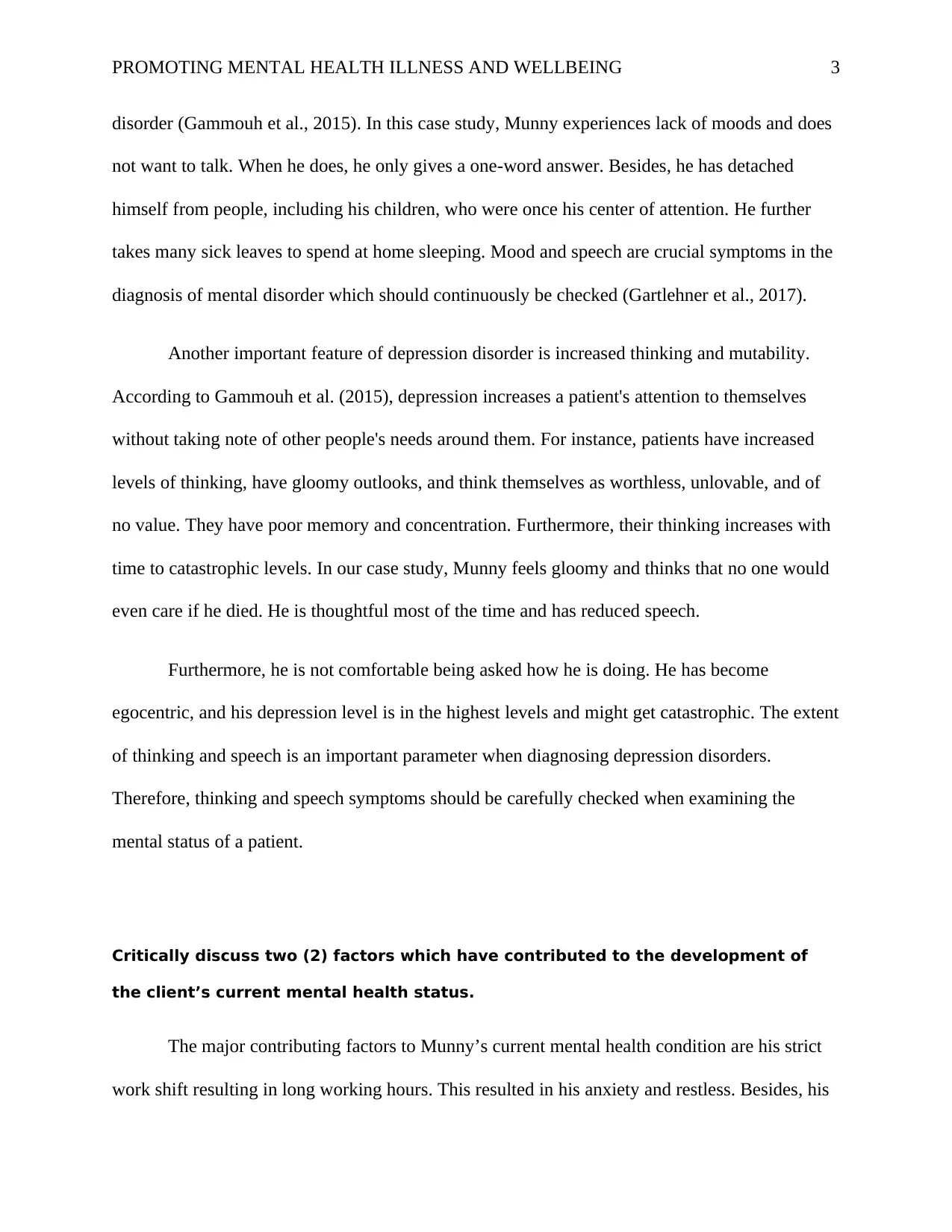
PROMOTING MENTAL HEALTH ILLNESS AND WELLBEING 3
disorder (Gammouh et al., 2015). In this case study, Munny experiences lack of moods and does
not want to talk. When he does, he only gives a one-word answer. Besides, he has detached
himself from people, including his children, who were once his center of attention. He further
takes many sick leaves to spend at home sleeping. Mood and speech are crucial symptoms in the
diagnosis of mental disorder which should continuously be checked (Gartlehner et al., 2017).
Another important feature of depression disorder is increased thinking and mutability.
According to Gammouh et al. (2015), depression increases a patient's attention to themselves
without taking note of other people's needs around them. For instance, patients have increased
levels of thinking, have gloomy outlooks, and think themselves as worthless, unlovable, and of
no value. They have poor memory and concentration. Furthermore, their thinking increases with
time to catastrophic levels. In our case study, Munny feels gloomy and thinks that no one would
even care if he died. He is thoughtful most of the time and has reduced speech.
Furthermore, he is not comfortable being asked how he is doing. He has become
egocentric, and his depression level is in the highest levels and might get catastrophic. The extent
of thinking and speech is an important parameter when diagnosing depression disorders.
Therefore, thinking and speech symptoms should be carefully checked when examining the
mental status of a patient.
Critically discuss two (2) factors which have contributed to the development of
the client’s current mental health status.
The major contributing factors to Munny’s current mental health condition are his strict
work shift resulting in long working hours. This resulted in his anxiety and restless. Besides, his
disorder (Gammouh et al., 2015). In this case study, Munny experiences lack of moods and does
not want to talk. When he does, he only gives a one-word answer. Besides, he has detached
himself from people, including his children, who were once his center of attention. He further
takes many sick leaves to spend at home sleeping. Mood and speech are crucial symptoms in the
diagnosis of mental disorder which should continuously be checked (Gartlehner et al., 2017).
Another important feature of depression disorder is increased thinking and mutability.
According to Gammouh et al. (2015), depression increases a patient's attention to themselves
without taking note of other people's needs around them. For instance, patients have increased
levels of thinking, have gloomy outlooks, and think themselves as worthless, unlovable, and of
no value. They have poor memory and concentration. Furthermore, their thinking increases with
time to catastrophic levels. In our case study, Munny feels gloomy and thinks that no one would
even care if he died. He is thoughtful most of the time and has reduced speech.
Furthermore, he is not comfortable being asked how he is doing. He has become
egocentric, and his depression level is in the highest levels and might get catastrophic. The extent
of thinking and speech is an important parameter when diagnosing depression disorders.
Therefore, thinking and speech symptoms should be carefully checked when examining the
mental status of a patient.
Critically discuss two (2) factors which have contributed to the development of
the client’s current mental health status.
The major contributing factors to Munny’s current mental health condition are his strict
work shift resulting in long working hours. This resulted in his anxiety and restless. Besides, his
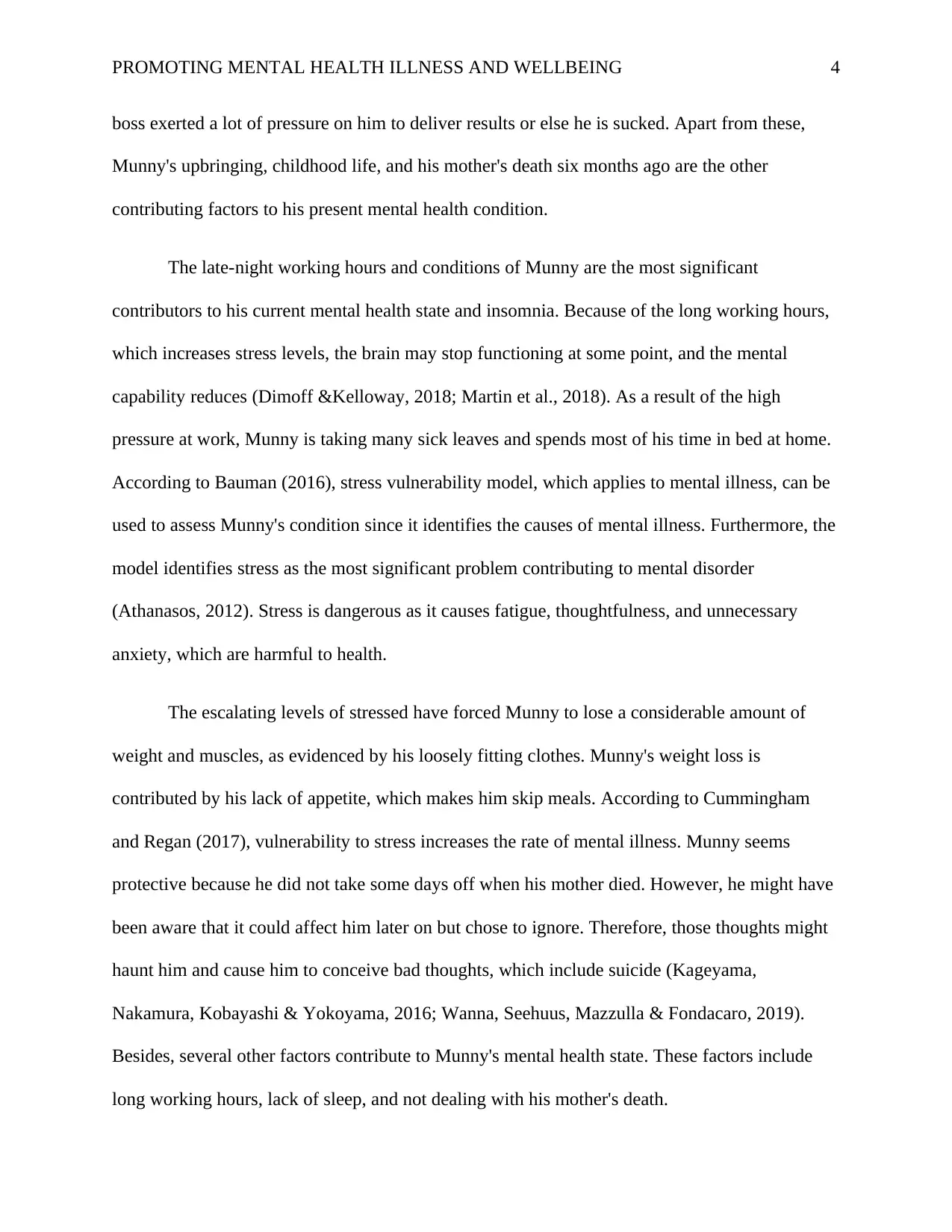
PROMOTING MENTAL HEALTH ILLNESS AND WELLBEING 4
boss exerted a lot of pressure on him to deliver results or else he is sucked. Apart from these,
Munny's upbringing, childhood life, and his mother's death six months ago are the other
contributing factors to his present mental health condition.
The late-night working hours and conditions of Munny are the most significant
contributors to his current mental health state and insomnia. Because of the long working hours,
which increases stress levels, the brain may stop functioning at some point, and the mental
capability reduces (Dimoff &Kelloway, 2018; Martin et al., 2018). As a result of the high
pressure at work, Munny is taking many sick leaves and spends most of his time in bed at home.
According to Bauman (2016), stress vulnerability model, which applies to mental illness, can be
used to assess Munny's condition since it identifies the causes of mental illness. Furthermore, the
model identifies stress as the most significant problem contributing to mental disorder
(Athanasos, 2012). Stress is dangerous as it causes fatigue, thoughtfulness, and unnecessary
anxiety, which are harmful to health.
The escalating levels of stressed have forced Munny to lose a considerable amount of
weight and muscles, as evidenced by his loosely fitting clothes. Munny's weight loss is
contributed by his lack of appetite, which makes him skip meals. According to Cummingham
and Regan (2017), vulnerability to stress increases the rate of mental illness. Munny seems
protective because he did not take some days off when his mother died. However, he might have
been aware that it could affect him later on but chose to ignore. Therefore, those thoughts might
haunt him and cause him to conceive bad thoughts, which include suicide (Kageyama,
Nakamura, Kobayashi & Yokoyama, 2016; Wanna, Seehuus, Mazzulla & Fondacaro, 2019).
Besides, several other factors contribute to Munny's mental health state. These factors include
long working hours, lack of sleep, and not dealing with his mother's death.
boss exerted a lot of pressure on him to deliver results or else he is sucked. Apart from these,
Munny's upbringing, childhood life, and his mother's death six months ago are the other
contributing factors to his present mental health condition.
The late-night working hours and conditions of Munny are the most significant
contributors to his current mental health state and insomnia. Because of the long working hours,
which increases stress levels, the brain may stop functioning at some point, and the mental
capability reduces (Dimoff &Kelloway, 2018; Martin et al., 2018). As a result of the high
pressure at work, Munny is taking many sick leaves and spends most of his time in bed at home.
According to Bauman (2016), stress vulnerability model, which applies to mental illness, can be
used to assess Munny's condition since it identifies the causes of mental illness. Furthermore, the
model identifies stress as the most significant problem contributing to mental disorder
(Athanasos, 2012). Stress is dangerous as it causes fatigue, thoughtfulness, and unnecessary
anxiety, which are harmful to health.
The escalating levels of stressed have forced Munny to lose a considerable amount of
weight and muscles, as evidenced by his loosely fitting clothes. Munny's weight loss is
contributed by his lack of appetite, which makes him skip meals. According to Cummingham
and Regan (2017), vulnerability to stress increases the rate of mental illness. Munny seems
protective because he did not take some days off when his mother died. However, he might have
been aware that it could affect him later on but chose to ignore. Therefore, those thoughts might
haunt him and cause him to conceive bad thoughts, which include suicide (Kageyama,
Nakamura, Kobayashi & Yokoyama, 2016; Wanna, Seehuus, Mazzulla & Fondacaro, 2019).
Besides, several other factors contribute to Munny's mental health state. These factors include
long working hours, lack of sleep, and not dealing with his mother's death.
Secure Best Marks with AI Grader
Need help grading? Try our AI Grader for instant feedback on your assignments.

PROMOTING MENTAL HEALTH ILLNESS AND WELLBEING 5
Munny’s childhood might have contributed chiefly to his current mental health situation
alongside stress from his boss. Adverse experiences during the early stages in life accumulate
thoughts and experiences which may later haunt an individual. Munny's father was short when he
was young, and they had to move as refugees before they secured a visa and moved out of the
country. When Munny thinks about losing his job, he probably remembers the painful experience
he went through as a child. Therefore, painful childhood experiences accumulate a lot of stress if
not dealt with properly and may cause mental stress (Gabrysch Fritsch, Priebe & Mundt, 2019;
Wanna et al., 2019). These experiences expose Munny to stress and cause his mental health to
destabilize.
The stress vulnerability model is crucial as it helps in getting the outcome and diagnosis
for Munny's mental health condition. The outcome of this assessment will afterward determine
the type of treatment that will suit his requirement. According to Fondacaro and Mazzulla
(2017), using drugs and alcohol is discouraged, and much emphasis is placed on medication.
Respect, empowerment, and hope are three (3) positive aspects of mental health recovery.
Using relevant literature and the case study, critically discuss how these three (3) principles
could positively contribute to the client's journey of healing.
Full recovery from mental health requires recovery-oriented practices which are focused
on the consumer. Recovery-oriented practice includes hope, respect, and empowerment, all of
which significantly influence a patient's recovery from mental health illness (Cunningham &
Regan, 2017; Gabrysch Fritsch, Priebe & Mundt, 2019). Of these factors, respect is the most
Munny’s childhood might have contributed chiefly to his current mental health situation
alongside stress from his boss. Adverse experiences during the early stages in life accumulate
thoughts and experiences which may later haunt an individual. Munny's father was short when he
was young, and they had to move as refugees before they secured a visa and moved out of the
country. When Munny thinks about losing his job, he probably remembers the painful experience
he went through as a child. Therefore, painful childhood experiences accumulate a lot of stress if
not dealt with properly and may cause mental stress (Gabrysch Fritsch, Priebe & Mundt, 2019;
Wanna et al., 2019). These experiences expose Munny to stress and cause his mental health to
destabilize.
The stress vulnerability model is crucial as it helps in getting the outcome and diagnosis
for Munny's mental health condition. The outcome of this assessment will afterward determine
the type of treatment that will suit his requirement. According to Fondacaro and Mazzulla
(2017), using drugs and alcohol is discouraged, and much emphasis is placed on medication.
Respect, empowerment, and hope are three (3) positive aspects of mental health recovery.
Using relevant literature and the case study, critically discuss how these three (3) principles
could positively contribute to the client's journey of healing.
Full recovery from mental health requires recovery-oriented practices which are focused
on the consumer. Recovery-oriented practice includes hope, respect, and empowerment, all of
which significantly influence a patient's recovery from mental health illness (Cunningham &
Regan, 2017; Gabrysch Fritsch, Priebe & Mundt, 2019). Of these factors, respect is the most
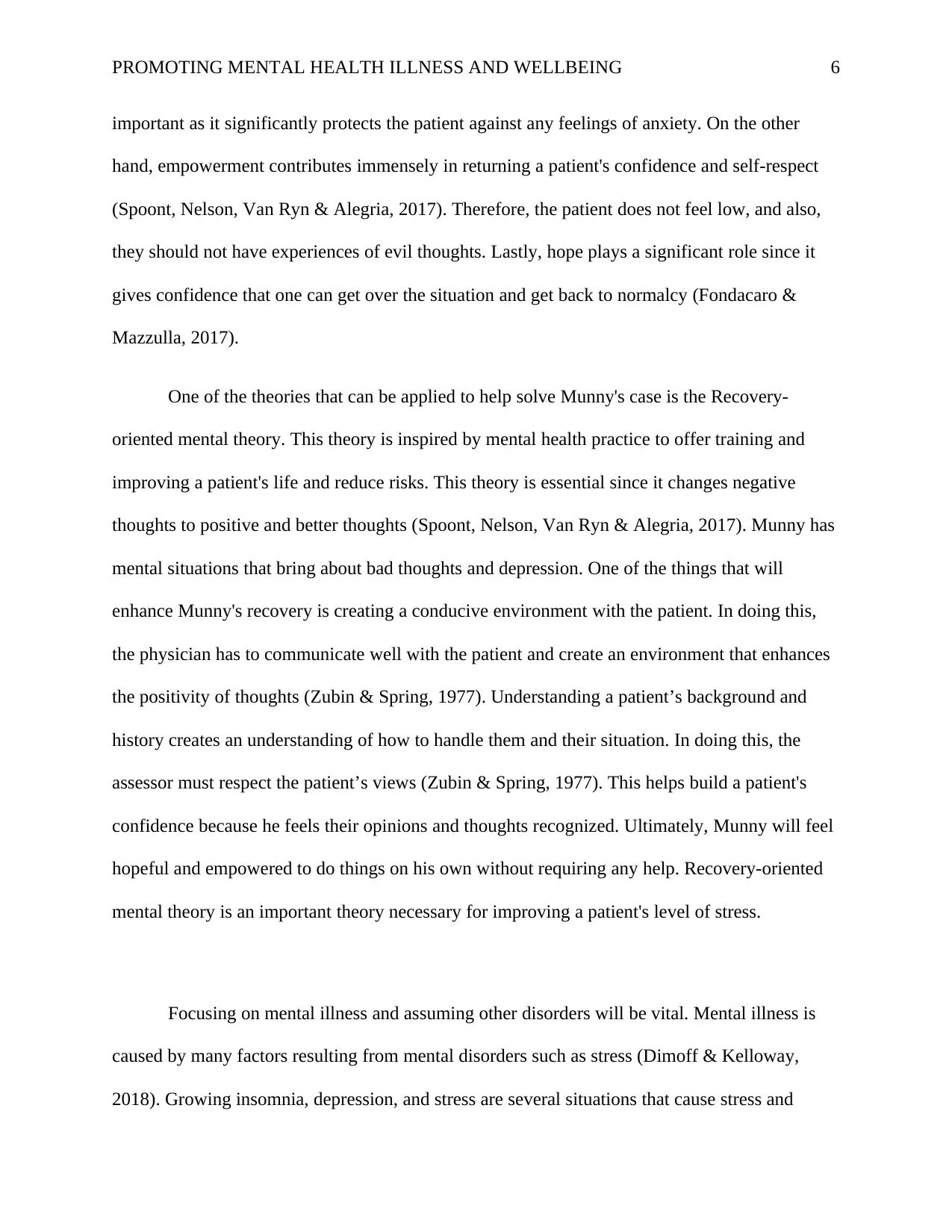
PROMOTING MENTAL HEALTH ILLNESS AND WELLBEING 6
important as it significantly protects the patient against any feelings of anxiety. On the other
hand, empowerment contributes immensely in returning a patient's confidence and self-respect
(Spoont, Nelson, Van Ryn & Alegria, 2017). Therefore, the patient does not feel low, and also,
they should not have experiences of evil thoughts. Lastly, hope plays a significant role since it
gives confidence that one can get over the situation and get back to normalcy (Fondacaro &
Mazzulla, 2017).
One of the theories that can be applied to help solve Munny's case is the Recovery-
oriented mental theory. This theory is inspired by mental health practice to offer training and
improving a patient's life and reduce risks. This theory is essential since it changes negative
thoughts to positive and better thoughts (Spoont, Nelson, Van Ryn & Alegria, 2017). Munny has
mental situations that bring about bad thoughts and depression. One of the things that will
enhance Munny's recovery is creating a conducive environment with the patient. In doing this,
the physician has to communicate well with the patient and create an environment that enhances
the positivity of thoughts (Zubin & Spring, 1977). Understanding a patient’s background and
history creates an understanding of how to handle them and their situation. In doing this, the
assessor must respect the patient’s views (Zubin & Spring, 1977). This helps build a patient's
confidence because he feels their opinions and thoughts recognized. Ultimately, Munny will feel
hopeful and empowered to do things on his own without requiring any help. Recovery-oriented
mental theory is an important theory necessary for improving a patient's level of stress.
Focusing on mental illness and assuming other disorders will be vital. Mental illness is
caused by many factors resulting from mental disorders such as stress (Dimoff & Kelloway,
2018). Growing insomnia, depression, and stress are several situations that cause stress and
important as it significantly protects the patient against any feelings of anxiety. On the other
hand, empowerment contributes immensely in returning a patient's confidence and self-respect
(Spoont, Nelson, Van Ryn & Alegria, 2017). Therefore, the patient does not feel low, and also,
they should not have experiences of evil thoughts. Lastly, hope plays a significant role since it
gives confidence that one can get over the situation and get back to normalcy (Fondacaro &
Mazzulla, 2017).
One of the theories that can be applied to help solve Munny's case is the Recovery-
oriented mental theory. This theory is inspired by mental health practice to offer training and
improving a patient's life and reduce risks. This theory is essential since it changes negative
thoughts to positive and better thoughts (Spoont, Nelson, Van Ryn & Alegria, 2017). Munny has
mental situations that bring about bad thoughts and depression. One of the things that will
enhance Munny's recovery is creating a conducive environment with the patient. In doing this,
the physician has to communicate well with the patient and create an environment that enhances
the positivity of thoughts (Zubin & Spring, 1977). Understanding a patient’s background and
history creates an understanding of how to handle them and their situation. In doing this, the
assessor must respect the patient’s views (Zubin & Spring, 1977). This helps build a patient's
confidence because he feels their opinions and thoughts recognized. Ultimately, Munny will feel
hopeful and empowered to do things on his own without requiring any help. Recovery-oriented
mental theory is an important theory necessary for improving a patient's level of stress.
Focusing on mental illness and assuming other disorders will be vital. Mental illness is
caused by many factors resulting from mental disorders such as stress (Dimoff & Kelloway,
2018). Growing insomnia, depression, and stress are several situations that cause stress and
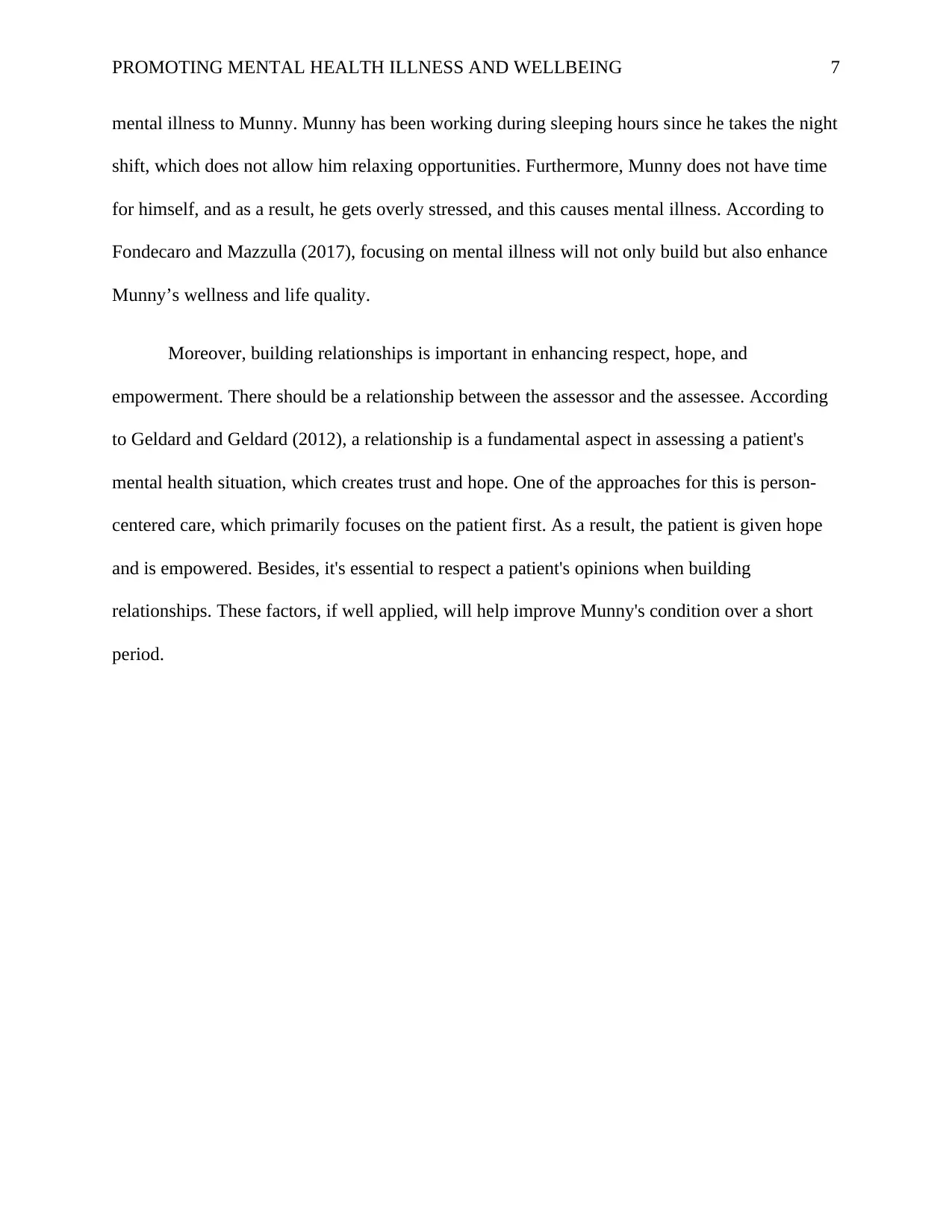
PROMOTING MENTAL HEALTH ILLNESS AND WELLBEING 7
mental illness to Munny. Munny has been working during sleeping hours since he takes the night
shift, which does not allow him relaxing opportunities. Furthermore, Munny does not have time
for himself, and as a result, he gets overly stressed, and this causes mental illness. According to
Fondecaro and Mazzulla (2017), focusing on mental illness will not only build but also enhance
Munny’s wellness and life quality.
Moreover, building relationships is important in enhancing respect, hope, and
empowerment. There should be a relationship between the assessor and the assessee. According
to Geldard and Geldard (2012), a relationship is a fundamental aspect in assessing a patient's
mental health situation, which creates trust and hope. One of the approaches for this is person-
centered care, which primarily focuses on the patient first. As a result, the patient is given hope
and is empowered. Besides, it's essential to respect a patient's opinions when building
relationships. These factors, if well applied, will help improve Munny's condition over a short
period.
mental illness to Munny. Munny has been working during sleeping hours since he takes the night
shift, which does not allow him relaxing opportunities. Furthermore, Munny does not have time
for himself, and as a result, he gets overly stressed, and this causes mental illness. According to
Fondecaro and Mazzulla (2017), focusing on mental illness will not only build but also enhance
Munny’s wellness and life quality.
Moreover, building relationships is important in enhancing respect, hope, and
empowerment. There should be a relationship between the assessor and the assessee. According
to Geldard and Geldard (2012), a relationship is a fundamental aspect in assessing a patient's
mental health situation, which creates trust and hope. One of the approaches for this is person-
centered care, which primarily focuses on the patient first. As a result, the patient is given hope
and is empowered. Besides, it's essential to respect a patient's opinions when building
relationships. These factors, if well applied, will help improve Munny's condition over a short
period.
Paraphrase This Document
Need a fresh take? Get an instant paraphrase of this document with our AI Paraphraser

PROMOTING MENTAL HEALTH ILLNESS AND WELLBEING 8
References
American Psychiatric Association. (2013). Diagnostic and statistical manual of mental disorders
(DSM-5®). American Psychiatric Pub.
Athanasos, P. (2012). MOOD DISORDERS. In Psychiatric & Mental Health Nursing. St. Louis,
MO: Elsevier Health Sciences.
Bauman, N. J. (2016). The stigma of mental health in athletes: are mental toughness and mental
health seen as contradictory in elite sport?.
Chiauzzi, E., Drahos, J., Sarkey, S., Curran, C., Wang, V., & Tomori, D. (2019). Patient
Perspective of Cognitive Symptoms in Major Depressive Disorder: Retrospective
Database and Prospective Survey Analyses. Journal of Participatory Medicine, 11(2),
e11167.
Cross, J. R., & Cross, T. L. (2015). Clinical and mental health issues in counseling the gifted
individual. Journal of Counseling & Development, 93(2), 163-172.
Cunningham, M. L., & Regan, M. A. (2017, October). Are Happy Drivers Better Drivers? The
Impact of Emotion, Life Stress, and Mental Health Issues on Driving Performance and
Safety. In Australasian Road Safety Conference, 2017, Perth, Western Australia,
Australia.
Dimoff, J. K., & Kelloway, E. K. (2018). With a little help from my boss: The impact of
workplace mental health training on leader behaviors and employee resource
utilization. Journal of occupational health psychology.
References
American Psychiatric Association. (2013). Diagnostic and statistical manual of mental disorders
(DSM-5®). American Psychiatric Pub.
Athanasos, P. (2012). MOOD DISORDERS. In Psychiatric & Mental Health Nursing. St. Louis,
MO: Elsevier Health Sciences.
Bauman, N. J. (2016). The stigma of mental health in athletes: are mental toughness and mental
health seen as contradictory in elite sport?.
Chiauzzi, E., Drahos, J., Sarkey, S., Curran, C., Wang, V., & Tomori, D. (2019). Patient
Perspective of Cognitive Symptoms in Major Depressive Disorder: Retrospective
Database and Prospective Survey Analyses. Journal of Participatory Medicine, 11(2),
e11167.
Cross, J. R., & Cross, T. L. (2015). Clinical and mental health issues in counseling the gifted
individual. Journal of Counseling & Development, 93(2), 163-172.
Cunningham, M. L., & Regan, M. A. (2017, October). Are Happy Drivers Better Drivers? The
Impact of Emotion, Life Stress, and Mental Health Issues on Driving Performance and
Safety. In Australasian Road Safety Conference, 2017, Perth, Western Australia,
Australia.
Dimoff, J. K., & Kelloway, E. K. (2018). With a little help from my boss: The impact of
workplace mental health training on leader behaviors and employee resource
utilization. Journal of occupational health psychology.
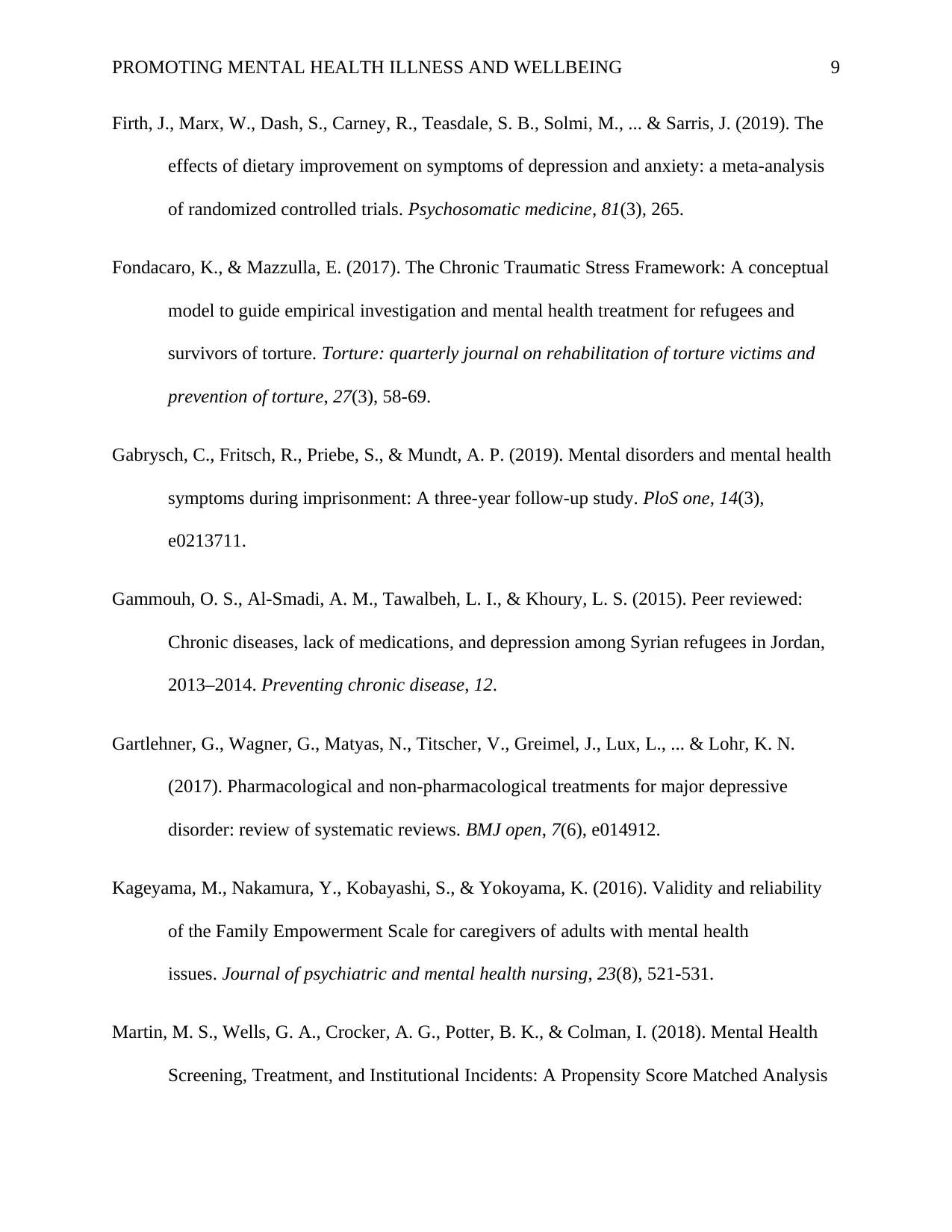
PROMOTING MENTAL HEALTH ILLNESS AND WELLBEING 9
Firth, J., Marx, W., Dash, S., Carney, R., Teasdale, S. B., Solmi, M., ... & Sarris, J. (2019). The
effects of dietary improvement on symptoms of depression and anxiety: a meta-analysis
of randomized controlled trials. Psychosomatic medicine, 81(3), 265.
Fondacaro, K., & Mazzulla, E. (2017). The Chronic Traumatic Stress Framework: A conceptual
model to guide empirical investigation and mental health treatment for refugees and
survivors of torture. Torture: quarterly journal on rehabilitation of torture victims and
prevention of torture, 27(3), 58-69.
Gabrysch, C., Fritsch, R., Priebe, S., & Mundt, A. P. (2019). Mental disorders and mental health
symptoms during imprisonment: A three-year follow-up study. PloS one, 14(3),
e0213711.
Gammouh, O. S., Al-Smadi, A. M., Tawalbeh, L. I., & Khoury, L. S. (2015). Peer reviewed:
Chronic diseases, lack of medications, and depression among Syrian refugees in Jordan,
2013–2014. Preventing chronic disease, 12.
Gartlehner, G., Wagner, G., Matyas, N., Titscher, V., Greimel, J., Lux, L., ... & Lohr, K. N.
(2017). Pharmacological and non-pharmacological treatments for major depressive
disorder: review of systematic reviews. BMJ open, 7(6), e014912.
Kageyama, M., Nakamura, Y., Kobayashi, S., & Yokoyama, K. (2016). Validity and reliability
of the Family Empowerment Scale for caregivers of adults with mental health
issues. Journal of psychiatric and mental health nursing, 23(8), 521-531.
Martin, M. S., Wells, G. A., Crocker, A. G., Potter, B. K., & Colman, I. (2018). Mental Health
Screening, Treatment, and Institutional Incidents: A Propensity Score Matched Analysis
Firth, J., Marx, W., Dash, S., Carney, R., Teasdale, S. B., Solmi, M., ... & Sarris, J. (2019). The
effects of dietary improvement on symptoms of depression and anxiety: a meta-analysis
of randomized controlled trials. Psychosomatic medicine, 81(3), 265.
Fondacaro, K., & Mazzulla, E. (2017). The Chronic Traumatic Stress Framework: A conceptual
model to guide empirical investigation and mental health treatment for refugees and
survivors of torture. Torture: quarterly journal on rehabilitation of torture victims and
prevention of torture, 27(3), 58-69.
Gabrysch, C., Fritsch, R., Priebe, S., & Mundt, A. P. (2019). Mental disorders and mental health
symptoms during imprisonment: A three-year follow-up study. PloS one, 14(3),
e0213711.
Gammouh, O. S., Al-Smadi, A. M., Tawalbeh, L. I., & Khoury, L. S. (2015). Peer reviewed:
Chronic diseases, lack of medications, and depression among Syrian refugees in Jordan,
2013–2014. Preventing chronic disease, 12.
Gartlehner, G., Wagner, G., Matyas, N., Titscher, V., Greimel, J., Lux, L., ... & Lohr, K. N.
(2017). Pharmacological and non-pharmacological treatments for major depressive
disorder: review of systematic reviews. BMJ open, 7(6), e014912.
Kageyama, M., Nakamura, Y., Kobayashi, S., & Yokoyama, K. (2016). Validity and reliability
of the Family Empowerment Scale for caregivers of adults with mental health
issues. Journal of psychiatric and mental health nursing, 23(8), 521-531.
Martin, M. S., Wells, G. A., Crocker, A. G., Potter, B. K., & Colman, I. (2018). Mental Health
Screening, Treatment, and Institutional Incidents: A Propensity Score Matched Analysis
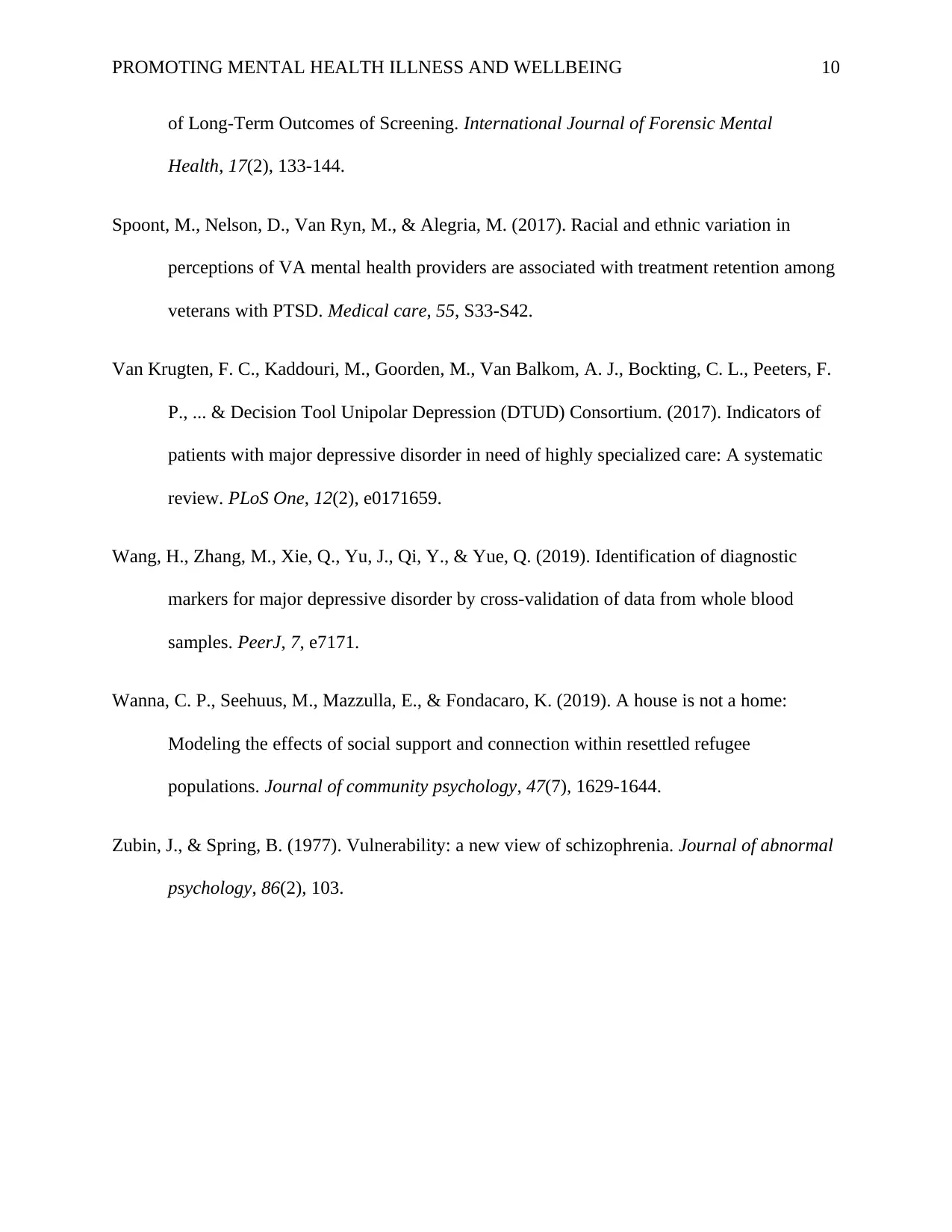
PROMOTING MENTAL HEALTH ILLNESS AND WELLBEING 10
of Long-Term Outcomes of Screening. International Journal of Forensic Mental
Health, 17(2), 133-144.
Spoont, M., Nelson, D., Van Ryn, M., & Alegria, M. (2017). Racial and ethnic variation in
perceptions of VA mental health providers are associated with treatment retention among
veterans with PTSD. Medical care, 55, S33-S42.
Van Krugten, F. C., Kaddouri, M., Goorden, M., Van Balkom, A. J., Bockting, C. L., Peeters, F.
P., ... & Decision Tool Unipolar Depression (DTUD) Consortium. (2017). Indicators of
patients with major depressive disorder in need of highly specialized care: A systematic
review. PLoS One, 12(2), e0171659.
Wang, H., Zhang, M., Xie, Q., Yu, J., Qi, Y., & Yue, Q. (2019). Identification of diagnostic
markers for major depressive disorder by cross-validation of data from whole blood
samples. PeerJ, 7, e7171.
Wanna, C. P., Seehuus, M., Mazzulla, E., & Fondacaro, K. (2019). A house is not a home:
Modeling the effects of social support and connection within resettled refugee
populations. Journal of community psychology, 47(7), 1629-1644.
Zubin, J., & Spring, B. (1977). Vulnerability: a new view of schizophrenia. Journal of abnormal
psychology, 86(2), 103.
of Long-Term Outcomes of Screening. International Journal of Forensic Mental
Health, 17(2), 133-144.
Spoont, M., Nelson, D., Van Ryn, M., & Alegria, M. (2017). Racial and ethnic variation in
perceptions of VA mental health providers are associated with treatment retention among
veterans with PTSD. Medical care, 55, S33-S42.
Van Krugten, F. C., Kaddouri, M., Goorden, M., Van Balkom, A. J., Bockting, C. L., Peeters, F.
P., ... & Decision Tool Unipolar Depression (DTUD) Consortium. (2017). Indicators of
patients with major depressive disorder in need of highly specialized care: A systematic
review. PLoS One, 12(2), e0171659.
Wang, H., Zhang, M., Xie, Q., Yu, J., Qi, Y., & Yue, Q. (2019). Identification of diagnostic
markers for major depressive disorder by cross-validation of data from whole blood
samples. PeerJ, 7, e7171.
Wanna, C. P., Seehuus, M., Mazzulla, E., & Fondacaro, K. (2019). A house is not a home:
Modeling the effects of social support and connection within resettled refugee
populations. Journal of community psychology, 47(7), 1629-1644.
Zubin, J., & Spring, B. (1977). Vulnerability: a new view of schizophrenia. Journal of abnormal
psychology, 86(2), 103.
1 out of 10
Related Documents
Your All-in-One AI-Powered Toolkit for Academic Success.
+13062052269
info@desklib.com
Available 24*7 on WhatsApp / Email
![[object Object]](/_next/static/media/star-bottom.7253800d.svg)
Unlock your academic potential
© 2024 | Zucol Services PVT LTD | All rights reserved.





